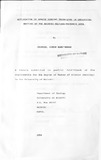| dc.contributor.author | Onywere, Simon M | |
| dc.date.accessioned | 2013-09-26T08:20:30Z | |
| dc.date.available | 2013-09-26T08:20:30Z | |
| dc.date.issued | 1990 | |
| dc.identifier.citation | A thesis submitted in partial fulfillment of the requirements for the degree of Master of Science (Geology) in the University of Nairobi. | en |
| dc.identifier.uri | http://erepository.uonbi.ac.ke:8080/xmlui/handle/123456789/56780 | |
| dc.description.abstract | The study deals with the applicallication
of space images in
geological mopping of the Nairobi-Kajiado-Machakos area. A
visnaI jnterpretation is made. The spectral analysis is
mnde usinq standard photographic faJse colour composites
(FCC) and black and white satellite imageries.
In the visual image analysis, linear features that were
observed both in small scale (1:500,000) and large scale
(1:125,000) are described. A discrimination of the geology
on the basis of the radiometric or tona1 signatures is
also made. The linear features to the west of the area are
a result of tectonic activities in the East African Rift
System that lead to faulting of the rocks. These linears
correspond to faults. The linear features to the east are
associated with the striations on the Precambrian
metamorphic gneisses of the Mozambique Belt. They
represent a relic of the original sedimentary structures.
Using the standard false colour composite (FCC) the area
was broad1y divided into two on the basis of spectral
reflectnnce ch~racteristics and texturol pr'ltterns.The
cnmbrian metamorphic rocks to the south and east are
mainly in the yellow/brown colour hues and the volcnnics
to the west are in the blue/green colour hues. A detailed
analysis of five selected areas in these broad divisions
is made basing the interpretation on a number of
measurable and recognizable features on the images
including geometric shapes or forms and patterns. The
information from the image is field checked and together
with collateral data is compiled into Precnmbrian metamorphic rocks to the south and east are
mainly in the yellow/brown colour hues and the volcnnics
to the west are in the blue/green colour hues. A detailed
analysis of five selected areas in these broad divisions
is made basing the interpretation on a number of
measurable and recognizable features on the images
including geometric shapes or forms and patterns. The
information from the image is field checked and together
with collateral data is compiled into a refined map, a
synthesized qeological map of the Nairobi-Kajiado-Machakos
arei'l | en |
| dc.language.iso | en | en |
| dc.title | Application of remote sensing techniques in geological of mapping Nairobi-Kajiado-Machakos area | en |
| dc.type | Thesis | en |
| local.publisher | school of science, Geology department, Universaity of Nairobi | en |

